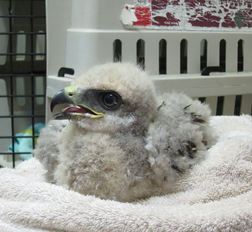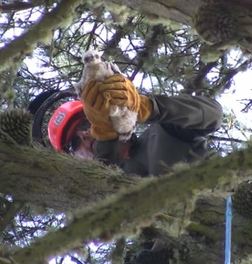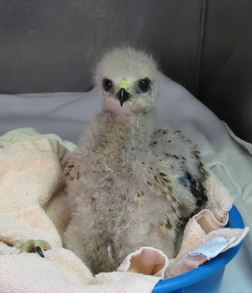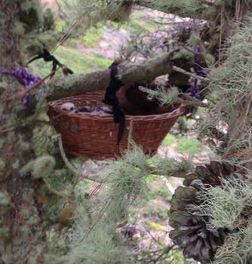WildCare's Wildlife Hospital treats nearly 4,000 ill, injured and orphaned wild animal patients from over 200 species every year. This is the story of two little patients and their incredible journey to WildCare and then back home.

When this baby Red-tailed Hawk came to WildCare after having fallen from her nest high in a pine tree, our first thought was that she would need medical care. How could she not be injured after her long fall?
But a thorough physical exam and x-rays showed that, indeed, somehow she had made it to the ground without injury. In addition, the exam revealed a full crop and excellent hydration, both indications that this baby's parents were taking good care of her.

Our hawk patient was perfectly healthy, but the reality of how lucky she was to have survived came home to rescuers when they approached the bottom of the massive pine tree under which our baby had been found.
Right next to the path was a second nestling of the same age and weight, but this nestling was dead. He must have hit his head in his fall.
The presence of the dead nestling confirmed that the nest was (or had been) in that specific tree, which was useful. When reuniting a nestling, finding the nest is often a challenge.

Cairnes scaled the 100+ foot pine in just a few minutes and scouted around for the nest in the topmost branches.
His search was made much easier when suddenly one of the parent Red-tailed Hawks floated past him and landed in the tree. Surprisingly, at the parent's feet was yet another fluffy nestling Red-tail! This one had somehow managed to stay aloft despite the failure of the nest, sticks of which Cairnes could see scattered around him.
The rest of his job had suddenly become more difficult, however, as the last thing he wanted to do was to cause this nestling to also jump from his precarious perch.
 What had happened to these birds' nest? We'll never know, but WildCare and Hungry Owl Project raptor experts suspect the parent Red-tails are inexperienced and may just not have been very good at nest building. High winds no doubt also contributed. Fortunately, a sturdy wicker laundry basket, provided by rescuers could provide the perfect nest replacement, even for the least competent nest builders!
What had happened to these birds' nest? We'll never know, but WildCare and Hungry Owl Project raptor experts suspect the parent Red-tails are inexperienced and may just not have been very good at nest building. High winds no doubt also contributed. Fortunately, a sturdy wicker laundry basket, provided by rescuers could provide the perfect nest replacement, even for the least competent nest builders!
Arborist Cairnes swiftly tied the basket into place, all the time watching the parent and baby for signs of stress. They seemed very calm, only occasionally glancing in his direction. As you can see in the video below, parent and chick are sitting less than ten feet away from him, but they seem mostly unperturbed by his presence.
The lack of stress up high was good news as, back on the ground, our baby hawk was removed from her carrier and gently placed in a soft bag to be lifted up to nest level.
Once she was aloft, Cairnes gently extracted the baby from the bag and set her in the wicker basket, now tied tightly in place and lined with leaves and pine needles. As she did in our care, this baby hawk immediately opened her mouth and started yelling for food-- our climber's hint to get out of the tree as soon as possible to allow the parent birds to find their baby.
After gently pulling down his climbing ropes, Cairnes and the other rescuers left the tree to further reduce stress on the family. Now it was up to the parent Red-tails to find and feed their prodigal child, and the responsibility of her human rescuers to keep an eye out and make sure both babies were being fed and attended.
The next day the parents were observed feeding both babies.
Another fluffy jumper

Unfortunately, the uncoordinated nestling must have lost his balance, because his sister's rescuer found him on the ground later that afternoon. He appeared alert and uninjured, which was great news, but Medical Staff was concerned he could have injured himself in the massive fall, so the rescuer braved rush-hour traffic to transport him to WildCare.
As they had with the first nestling, WildCare Medical Staff gently performed a thorough exam, and then took radiographs (x-rays) of the little bird's entire body to check for broken bones. There were none! This bird was just as lucky as his sibling to have made the fall without injury, and he was also noticeably healthy and well-fed.
Medical staff kept him overnight for observation and then arranged with Cairnes to climb the tree again and put this fluffy baby with his sister.

Cairnes scaled the tree again, and then sat very still a distance from the nest to allow the birds to get used to him. Periodically he would readjust his safety ropes and move closer to the nest, all the time watching the birds for stress. Luckily, he had his camera with him and was able to capture amazing footage of this wild Red-tail family in action, high up in their own habitat.
Again, the mother Red-tail exhibited surprising tolerance to his presence. As Cairnes watched and filmed, the male hawk flew in with prey for his family, which the female promptly tore apart and fed to the nestling in the basket. Then she hopped into the basket with her baby and calmly surveyed her surroundings, which included Cairnes. Watch in the video below.
But Cairnes needed to get close enough to the basket to pop the second chick in, so he continued to inch closer. Still not overly concerned, the mother hawk kept a close eye on him from her basket resting spot, but didn't move out of the nest. Watch the mother Red-tail eyeing Cairnes as he moves closer to the nest in the video below.
Finally, after a long and chilly wait high in the tree, Cairnes called for the second baby to be sent up on a lowered rope. After pulling him up, Cairnes opened the box and carefully lifted him out of the box. In one quick motion he then plopped the baby into the basket and scooted out of the way.
From the ground, rescuers saw a fluttering of wings as the mother hawk tried to figure out what had just happened, but she immediately settled down again, accepting that her family had been reunited.
At last check, the parents were feeding both chicks in their sturdy laundry-basket nest.
Reuniting really DOES feel so good!
WildCare is a 501(c)3 nonprofit organization supported almost entirely by private donations and individual memberships. Learn more about all our raptor patients this summer at wildcarebayarea.org.
